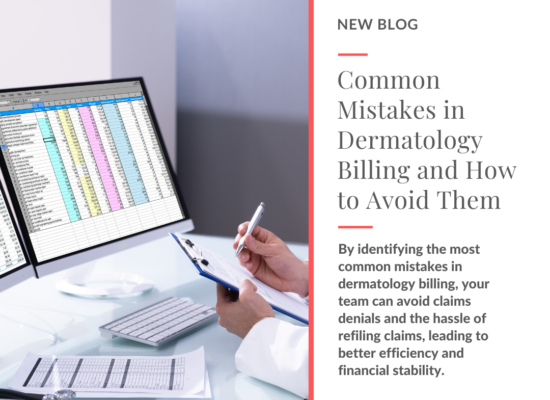Revenue management is arguably as important as your patient management. While your primary focus undoubtedly remains on the health and welfare of your patients, managing your practice also requires due diligence – for your own – and your employees welfare too. Just as you would monitor a patient “full circle,” from the moment they walk into your dermatology practice, until the time they leave after diagnosis and treatment, you’ll want to ensure that you treat your revenue cycle management the same way. Here’s what “coming full circle” should mean to you and your business when it comes to managing your revenue cycle.
First – Let’s Talk WHAT. What is Healthcare Revenue Cycle Management?
In its most simplistic definition, revenue management has to do with tracking and managing the monetary portion of patient management – for the benefit of your practice as a whole. From the moment a patient registers for care within your practice, until the time of their discharge, as their care provider you have certain responsibilities for tracking and managing records of that care for billing and payment purposes. Read on to see how to go about the process in a way that helps to ensure you are reimbursed for the services provided and identifies potential gaps so that you don’t get caught up in a different cycle – resubmitting denied claims! An effective and efficient RCM ensures you are also able to profit from your work and to pay your employees, too.
Next – Let’s Talk PITFALLS. RCM is Complex!
Let’s make the reading a little easier by referring to the revenue cycle management as RCM for the remainder of our time together. RCM is rife with complexities – perhaps these days more than ever before. Effective billing and tracking procedures require you and your team to be vigilant, knowledgeable and constantly current on changing insurance billing codes. Add in “debt collector” responsibilities, managing deductibles and/or co-pays, changing technology and other factors and you have a recipe for stressed, overworked clinic staff and the potential for cost recovery to become overwhelming. If RCM is becoming an issue for your dermatology practice you may even want to consider outsourcing. Recent research suggests that RCM outsourcing will increase from approximately $11 billion, just a few years ago, to over $23 billion by year-end 2023. If this is something you are considering for your practice, consider contacting the experts at Derm Care Billing Consultants where managing dermatology billing practices is all we do.
Now – What Are The Steps in RCM?
It’s important that both you and your staff team understand every step of RCM from the beginning to the end, with successfully being reimbursed – closing the circle on the patient care/billing/payment/discharge cycle.
Preregistration/Registration and Authorization
From the moment a patient first calls your practice the RCM begins. Maximize the potential for a positive revenue outcome during this initial contact by ensuring you collect all relevant patient AND insurance information during registration. Ensure the patient fully understands their co-pay and/or deductible and payment responsibilities and/or collect these funds up front before the start of patient care. Knowing what to expect rather than being caught off guard by an invoice means patients are more likely to pay. During this time, seek authorization from the insurer using the appropriate codes to prevent potential claims denials. Ensure any necessary referrals are also on file as this is often another reason claims are denied.
Coding, Charges and Software Tools
Next up you’ll need to rely on your administrative, nursing and accounting teams to ensure all procedures are properly recorded, charged and tracked. You might choose to invest in RCM software to help streamline this process but whether you do or don’t, there is a possibility of leaving “revenue on the table” if you miss any vital step along the way. Missing codes, or miscoded treatments lead to claims not being fully paid or claims being denied altogether. Not tracking patient information properly from registration through treatment
to discharge could leave you with no means of revenue recovery if insurance denies the claim.
Claims Submission, Tracking and Outcomes
Do you have adequate staff to complete not just the claims submission paperwork but to also track outcomes? The process of submissions, approvals or denials is cumbersome and if additional paperwork is requested, or a claim is denied due to incorrect or missing codes, the process of follow-up and resubmission is critical to ensuring you are paid for services rendered. At this point, payment might be a successful outcome and you’ve come “full circle,” but if the alternative is a denial you are only halfway there. Do you have all the information you need to close the gap? If you’ve done the upfront work, there’s a good chance you can still collect payment but if you’ve missed any steps along the way it will be more challenging to do so. This is where utilizing the services of a complete medical billing consultant might make sense. Up to date on coding, using the best software tools and committed to the practice of dermatology in particular, Derm Care Billing Consultants are experts at managing every step of the revenue management cycle so you don’t have to.
Second Chance Resubmissions
As stated above, you need to track remittances or you’ll never know what you’re missing. In some cases, contractual remittances will mean you only receive payment for the set fees according to a fee schedule. If you don’t track patient information you’ll miss the opportunity to collect any additional fees directly. If a claim is not paid, or not paid in full due to incorrect coding, you can potentially resubmit the claim, but only if you understand what went wrong in the first place, how to fix the errors, have adequate staffing to do so, and then you start the tracking and payment process all over again. Do you even have an appeals process in place? Some insurance carriers even demand that claims are submitted within a certain time frame in order to be reimbursed so as part of your RCM you may wish to complete an audit of your processes to identify gaps and opportunities if you find you are consistently having claims denied.
Patients and Patience!
At this stage of the process you are close to coming full circle. Either you have collected payment, and discharged the patient from care, or you’ve been denied and it’s time to go back to the patient for possible reimbursement. This requires patience, commitment and dedication to the task. Acting as a collection agency is not something many office administrators are trained for or willing to do. Is there a practice in place for issuing statements to patients? What are your follow up terms? Do you charge interest on late
payments? Perhaps it’s time to evaluate your entire billing, submissions and payments cycle.
RCM is challenging for any practice. We’ve simplified the explanation here but no doubt, if you’ve been providing dermatology care for some time, you’re already aware of how cumbersome collections can be. If you are just starting a practice, you might want to review this process, chat with other service providers or contact a professional outsourcing service to review your options. We’re Derm Care Billing Consultants and we provide exceptional revenue cycle management for dermatology practitioners across the US. Reduce your collections wait times, get paid the first time, 97% of the time, and experience 24/7 web based access to our services. We help ensure your revenue cycle management comes full circle – ensuring you get paid!





